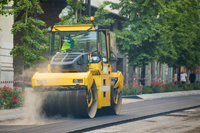 When it comes to cost effectiveness, asphalt is a great option for driveways, roads, and commercial parking lots. And because of its many advantages, asphalt is becoming one of the most common paving products in North America. It offers a smooth ride, which reduces interior noise during driving and is a safe way to get to where you’re going.
When it comes to cost effectiveness, asphalt is a great option for driveways, roads, and commercial parking lots. And because of its many advantages, asphalt is becoming one of the most common paving products in North America. It offers a smooth ride, which reduces interior noise during driving and is a safe way to get to where you’re going.
Paving with asphalt also reduces time spent during construction because it doesn’t require time to cure. This reduces traffic delays, ensures your store opens on opening day, and keeps your customers comfortable and happy.
For today we’re going to focus on signs that may be indicating it’s time to repair or replace parts of your commercial asphalt parking lot.
Commercial Parking Lots.
If you’re already the proud owner of an asphalt parking lot, you’ve already accepted the fact that it’s going to need repairing at some point, so it makes sense to inform yourself about the warning signs, and then to also understand what your next step should be. You don’t want to repave asphalt that only needs repairing, and you don’t want to only repair asphalt that needs replacing.
When analyzing your asphalt consider the following:
Check to see if it’s showing signs of cracking.
Cracking can take many forms, including shrinkage, widening, edge cracks, slippage (brought about by improper compaction), and reflection (found in older cracks). If you notice cracking, connect with a paver and they’ll let you know the best solution. And don’t wait, because the problem will only get worse over time. And the longer the problem goes unresolved, the more expensive the solution gets.
Rutting.
There are two types of rutting: mix rutting and subgrade rutting.
Mix rutting is when the pavement surface exhibits wheel path depressions as a result of compaction/mix design problems. Subgrade rutting is when the subgrade exhibits wheel path depressions due to loading. In this case, the pavement settles into the subgrade ruts causing surface depressions in the wheel path.
Ruts can be dangerous.
Ruts can become filled with water which sometimes leads to vehicle hydroplaning, and are hazardous because they can pull a vehicle into the rut path temporarily taking control away from the driver.
Rut Repair.
Rutted pavement should be investigated to determine the root causes, compaction, subgrade rutting, poor mix design or studded tire wear). Slight ruts (< 1/3 inch deep) can generally be left untreated. Pavement with deeper ruts should be leveled and overlaid. (Source: pavementinteractive.org).
Breakdown.
This pretty much means exactly what it sounds like. If your parking lot has pot holes, is rutting, and has extreme cracking, it’s breaking down. It’s time to replace it with new asphalt.
*Tip. Have you noticed puddles forming in your parking lot? Contact a paver and take care of the problem before it gets worse. This will actually prolong the life of your parking lot.
Want more info on asphalt? Download our eBook to help you choose the best material for your next job.


